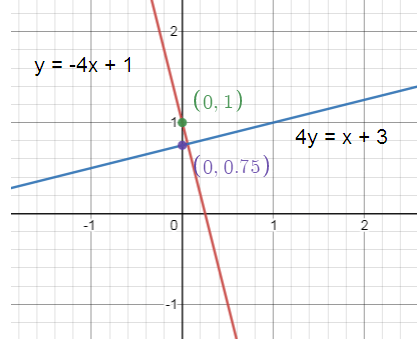DETERMINE IF THE LINES ARE PARALLEL PERPENDICULAR OR NEITHER
Subscribe to our ▶️ YouTube channel 🔴 for the latest videos, updates, and tips.
How to decide whether the lines are parallel, perpendicular or neither ?
Parallel lines :
Parallel lines will have same slope and different y-intercepts.
m1 = m2
m1 and m2 are the slope of those two lines.
Perpendicular lines :
If two lines are perpendicular then product of their slopes will be equal to -1.
m1.m2 = -1
Coincident lines :
Coincident lines will have same slope and same y-intercepts.
The lines which has no relationship in between the slopes and y-intercepts can be considered neither.
Tell whether the lines are parallel, perpendicular, or neither.
Problem 1 :
Line 1 : through (-3, -7) and (1, 9)
Line 2 : through (-1, -4) and (0, -2)
Solution :
|
Slope of line 1 : x1 = -3, y1 = -7 x2 = 1, y2 = 9 m1 = (y2 – y1)/(x2 – x1) = (9 + 7)/(1 + 3) = 16/4 = 4 |
Slope of line 2 : x1 = -1, y1 = -4 x2 = 0, y2 = -2 m = (y2 – y1)/(x2 – x1) = (-2 + 4)/(0 + 1) = 2/1 = 2 |
They are not parallel, they are not perpendicular. So, the lines are neither.
Problem 2 :
Line 1 : through (2, 7) and (-1, -2)
Line 2 : through (3, -6) and (-6, -3)
Solution :
|
Slope of line 1 : x1 = 2, y1 = 7 x2 = -1, y2 = -2 m1 = (y2 – y1)/(x2 – x1) = (-2 - 7)/(-1 - 2) = -9/(-3) = 3 |
Slope of line 2 : x1 = 3, y1 = -6 x2 = -6, y2 = -3 m2 = (y2 – y1)/(x2 – x1) = (-3 + 6)/(-6 - 3) = 3/-9 = -1/3 |
m1 x m2 = 3 (-1/3)
m1 x m2 = -1
So, the lines are perpendicular.
Determine whether
the graphs of each pair of equations are parallel, perpendicular, or neither.
Problem 3 :
y = 3x + 4
y = 3x + 7
Solution :
y = 3x + 4 ----- (1)
y = 3x + 7 ------(2)
Comparing the above equations with slope intercept form
y = mx + b, we get
m1 = 3, m2 = 3
b1 = 4, b2 = 7
Both lines are having same slope. but different y – intercepts. So, the given lines are parallel.

Problem 4 :
y = -4x + 1
4y = x + 3
Solution :
y = -4x + 1 ------(1)
4y = x + 3
y = x/4 + 3/4 ------(2)
m = -4, m = 1/4
m1 ⋅ m2 = -4 (1/4)
m1 ⋅ m2 = -1
Since the product of the slopes is equal to -1. The lines are perpendicular.

Problem 5 :
y = 2x - 5
y = 5x - 5
Solution :
y = 2x – 5 -----(1)
y = 5x - 5 -----(2)
Comparing (1) and (2)
y = mx + b
m = 2, m = 5
b = -5, b = -5
There is no relationship between slopes, so they are neither.
Problem 6 :
y = -1/3x + 2
y = 3x - 5
Solution :
y = -1/3x + 2 -----(1)
y = 3x - 5 -----(2)
y = mx + b
m1 = -1/3, m2 = 3
b = 2, b = -5
m1 = -1/3, m2 = 3
m1 ⋅ m2 = (-1/3) ⋅ 3
Product of the slope is equal to -1. So, the lines are perpendicular.

Problem 7 :
y = 3/5x - 3
5y = 3x - 10
Solution :
y = 3/5x – 3 ------(1)
5y = 3x - 10
y = 3/5x - 10 ------(2)
y = mx + b
m1 = 3/5, m2 = 3/5
b = -3, b = -10
Both lines have the same slope but have different y-intercepts. So, the lines are parallel.
Problem 8 :
y = 4
4y = 6
Solution :
y = 4 ------(1)
4y = 6
y = 6/4
y = 3/2------(2)
Both are horizontal lines and they will not intersect.
Subscribe to our ▶️ YouTube channel 🔴 for the latest videos, updates, and tips.
Recent Articles
-
Finding Range of Values Inequality Problems
May 21, 24 08:51 PM
Finding Range of Values Inequality Problems -
Solving Two Step Inequality Word Problems
May 21, 24 08:51 AM
Solving Two Step Inequality Word Problems -
Exponential Function Context and Data Modeling
May 20, 24 10:45 PM
Exponential Function Context and Data Modeling